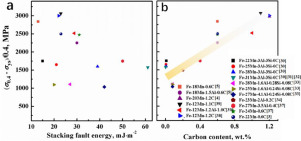当前位置:
X-MOL 学术
›
Scr. Mater.
›
论文详情
Our official English website, www.x-mol.net, welcomes your feedback! (Note: you will need to create a separate account there.)
The role of interstitial carbon atoms on the strain-hardening rate of twinning-induced plasticity steels
Scripta Materialia ( IF 6 ) Pub Date : 2020-03-01 , DOI: 10.1016/j.scriptamat.2019.11.047 Z.C. Luo , M.X. Huang
Scripta Materialia ( IF 6 ) Pub Date : 2020-03-01 , DOI: 10.1016/j.scriptamat.2019.11.047 Z.C. Luo , M.X. Huang

|
Abstract Synchrotron X-ray diffraction was applied to measure the dislocation density of two twinning-induced plasticity (TWIP) steels with different carbon content but comparable stacking fault energy (SFE). We found that the dislocation density of the carbon-alloyed TWIP is much higher than that of the carbon-free TWIP steel, though these two steels possess similar twin volume fraction. It indicates that the excellent tensile and strain-hardening properties of the carbon-alloyed TWIP steels are mainly caused by the high dislocation density induced by the carbon-dislocation interaction. Carbon-free TWIP steels are conventional low SFE fcc alloys similar to 316L stainless steel.
中文翻译:

间隙碳原子对孪生诱导塑性钢应变硬化率的影响
摘要 采用同步辐射 X 射线衍射技术测量了两种具有不同碳含量但具有相似堆垛层错能 (SFE) 的孪生诱导塑性 (TWIP) 钢的位错密度。我们发现碳合金 TWIP 的位错密度远高于无碳 TWIP 钢,尽管这两种钢具有相似的孪晶体积分数。这表明碳合金 TWIP 钢优异的拉伸和应变硬化性能主要是由碳-位错相互作用引起的高位错密度造成的。无碳 TWIP 钢是类似于 316L 不锈钢的常规低 SFE fcc 合金。
更新日期:2020-03-01
中文翻译:

间隙碳原子对孪生诱导塑性钢应变硬化率的影响
摘要 采用同步辐射 X 射线衍射技术测量了两种具有不同碳含量但具有相似堆垛层错能 (SFE) 的孪生诱导塑性 (TWIP) 钢的位错密度。我们发现碳合金 TWIP 的位错密度远高于无碳 TWIP 钢,尽管这两种钢具有相似的孪晶体积分数。这表明碳合金 TWIP 钢优异的拉伸和应变硬化性能主要是由碳-位错相互作用引起的高位错密度造成的。无碳 TWIP 钢是类似于 316L 不锈钢的常规低 SFE fcc 合金。



























 京公网安备 11010802027423号
京公网安备 11010802027423号